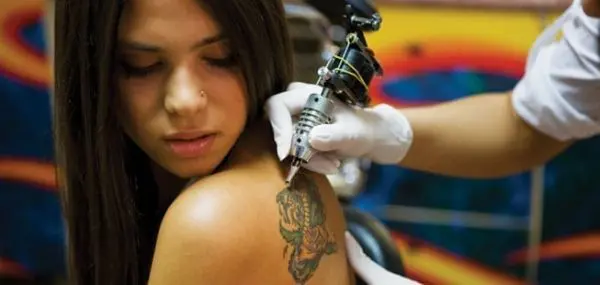Q: Why is indoor tanning so popular with teens?
Woodhouse: There is a cultural perception that one has a healthy glow when the skin is not too pale. Our society promotes the idea that tanned skin looks healthier and more attractive. Teens who care a lot about their appearance want the tan in order to look more attractive. Also, the process of tanning causes the release of endorphins into the blood stream, contributing to a feeling of well-being. These endorphins may contribute to tanning becoming somewhat of an addiction.
Q: What are typical indoor tanning processes?
Woodhouse: Tanning beds/booths (beds) and spray tans.
Q: Do tanning beds use both Ultraviolet A (UVA) and Ultraviolet B (UVB) bulbs?
Woodhouse: Tanning beds use mostly very high doses of Ultraviolet A light. Ultraviolet A light is a form of radiation. Most forms of radiation can be harmful if their intensity is high. With sun tanning, intense ultraviolet light does damage as well.
Q: What is UVA light?
Woodhouse: UVA light is a longer wavelength of light that penetrates very deeply into the skin. Because it has a longer wavelength, it also penetrates through clothes, car windows and clouds. UVA damage is accumulated without really knowing it is happening because the UVA light can tan the skin without burning it. Although it does not burn the skin, UVA light is very carcinogenic.
Q: How does using a tanning bed affect the skin?
Woodhouse: Usually, the UVA from natural sunlight is accumulated slowly and tanning occurs over days but with tanning beds, large doses of UVA are given to cause an immediate tan. High doses of UVA light penetrate the skin and damage the DNA of the skin cells. When using a tanning bed, the degree of radiation damage is not always clear because the UVA light causes tanning with no sunburn.
Q: What risks are associated with tanning bed use? What are some tanning bed dangers?
Woodhouse: Use of tanning beds increases the risk for skin cancer, wrinkles, leathery skin and age spots. Cancer is the most dangerous risk. Basal cell skin cancer is the most common type of cancer and grows where the body is exposed to high doses of ultraviolet light and tends to occur where damage has been accumulated over time. This is likely the reason why skin cancer is most common on the nose, and unfortunately, it usually requires surgical removal. Other types of skin cancer that are more life-threatening are squamous cell carcinoma and melanoma, both of which are highly related to ultraviolet radiation.
Q: How does using a tanning bed cause cancer?
Woodhouse: Tanning beds use very high doses of UVA radiation that cause mutations in the DNA of the skin cells. Although thousands of cells are mutated with each exposure to radiation and each exposure is enough to be problematic, our immune system fortunately destroys many of them. However, many mutations are left behind. Each and every day those cells replicate and replace themselves. Over the course of years, the mutations accumulate and suddenly a cell begins to grow too fast and becomes cancer.
Q: Does skin color have anything to do with tanning bed safety?
Woodhouse: The entire function of skin pigmentation is to provide a natural shield to protect the skin from radiation.Tanning happens when high doses of radiation from UVA and UVB light are able to penetrate the skin and damage the cells. The darker the skin, the less radiation is able to penetrate the skin. Those with lighter skin are at a higher risk of accumulating more radiation, and are thus more prone to skin cancers.
Q: Can rays from a tanning bed/booth help increase vitamin D levels?
Woodhouse: Ultraviolet light B (UVB) helps increase Vitamin D. Tanning beds and booths use very little UVB; they use mostly UVA, which does not increase one’s vitamin D level.
Most people can get enough vitamin D from 15-20 minutes of natural sunlight on a less cancer prone area such as the stomach or arms. More importantly, people with higher risks for skin cancer can obtain Vitamin D through diet or vitamin supplements.
Q: Do teens have any higher risk?
Woodhouse: Yes, tanning beds/booths are more dangerous for teens because teens are more likely to become addicted to the beds/booths, causing excessive exposure to the UVA light. Also, young people exposed to high levels of radiation may get skin cancer at an earlier age.
Q: Can tanning beds/booths treat psoriasis or any other skin ailments?
Woodhouse: It may help, but there are safer and more effective ways to treat psoriasis.
Q: Are all tanning beds/booths the same? What are the differences?
Woodhouse: Some tanning beds may have a stronger light than others. The higher intensity will tan faster, but it may also cause more damage to cells.
Q: Why do you think there is a higher rate of skin cancer cases?
Woodhouse: There is a true recognized epidemic of skin cancer. The damage from UV light is accumulated and more pronounced the longer we live. Because people are living longer, we are seeing many more skin cancers. At one time, the traditional dress included hats and longer sleeves that naturally protected the skin more from sun exposure. As the culture changed and people began to expose more skin, the radiation began to accumulate. We now understand that danger but, in the meantime, we have a massive problem.
Q: What is spray tan?
Woodhouse: Spray tans utilize a chemical called Dihydroxy Accetone (DHA) that causes a brown color on the surface skin cells. Spray tan is for appearance only, and it does not contain protection from radiation.
Q: How safe is a spray tan? Are spray tans dangerous?
Woodhouse: Currently, there are no known long-term spray tan dangers; however, because it is a chemical, it should not be inhaled and eye protection should always be used during the tanning process.




